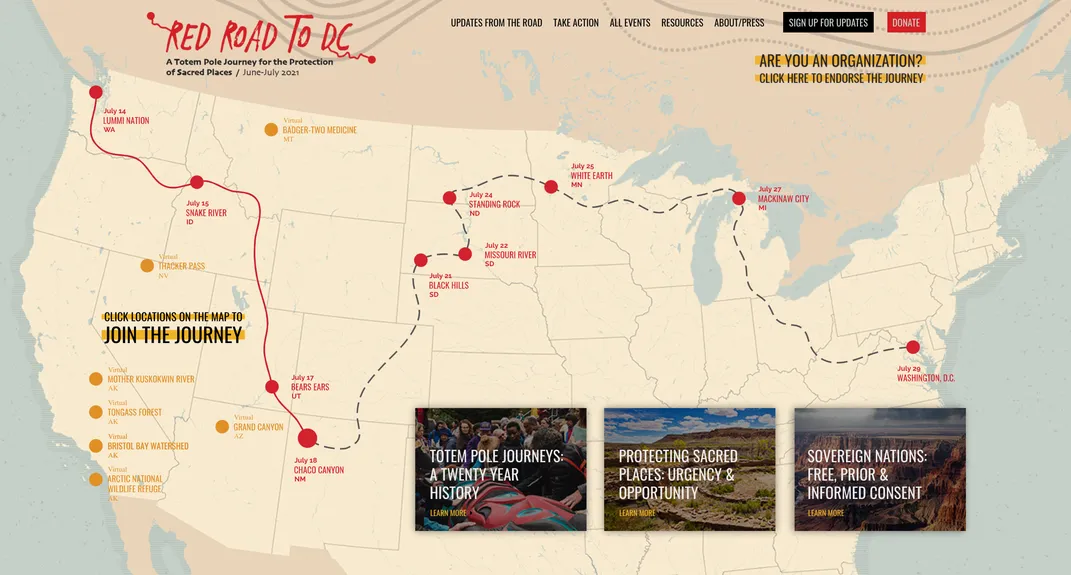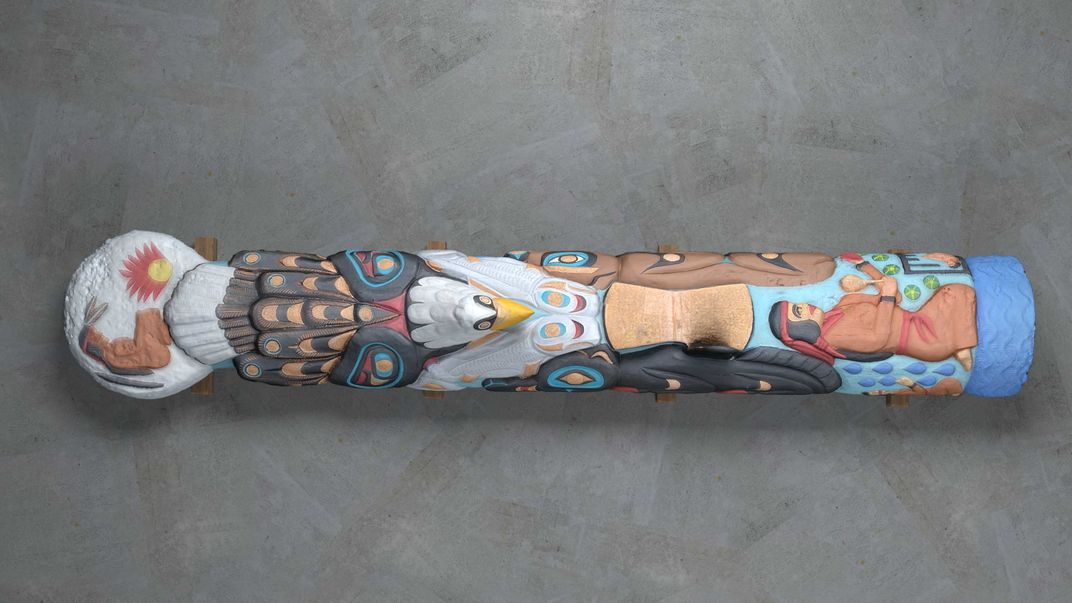Why Indigenous Activists Are Driving a 25-Foot Totem Pole Across the Country
Master carvers from the Lummi Nation, a Native tribe in Washington, crafted the 5,000-pound object from a single red cedar tree
:focal(2428x1880:2429x1881)/https://tf-cmsv2-smithsonianmag-media.s3.amazonaws.com/filer/e6/8d/e68d2e56-80c6-48f4-a656-0de13f392406/gettyimages-1324271481.jpg)
Earlier this month, Native American activists embarked on an epic, cross-country trek that began in Washington state and is slated to end on the front lawn of the Smithsonian’s National Museum of the American Indian (NMAI) in Washington, D.C. on July 29.
The group is carrying precious cargo: namely, a monumental totem pole strapped to the back of a jumbo tractor-trailer, reports National Geographic. Organizers planned the journey to pressure the federal government, under President Joe Biden, to take immediate action to protect endangered areas that hold environmental and cultural significance for Native American tribes across the country.
Measuring 25 feet tall and 43 inches wide, the multicolored totem pole weighs some 4,900 pounds, reports Dana Hedgpeth for the Washington Post. Over two weeks, the object and its caretakes will cross the country on a trip dubbed the Red Road to D.C., stopping at sacred Indigenous sites including Bears Ears National Monument in Utah; Chaco Canyon in New Mexico; Standing Rock Reservation in North Dakota; and Mackinaw City in Michigan, where the controversial Line 5 oil pipeline threatens the environmentally sensitive straits connecting Lake Michigan to Lake Huron. (Audiences can track the totem pole’s current location on the Red Road to D.C. website.)
A petition on the campaign’s website calls on Biden and Congress to consult tribes on projects that affect Native lands, waters and resources. As of July 15—the second day of the journey—the petition had received over 6,000 signatures, according to a statement.
Native American tribes in the Pacific Northwest have been carving richly decorated, colorful totem poles for thousands of years. During the 19th and 20th centuries, artists continued to make totems despite the intervention of colonizers and non-Indigenous groups who stole, destroyed or disrespected them, per National Geographic.
As Kimberly R. Fulton Orozco wrote for Smithsonian magazine earlier this year, Indigenous artists have, in recent decades, revived the practice of totem pole carving as “part of a larger movement to counter threats to their cultural sovereignty and resist estrangement from their heritage.”
This summer’s totem pole journey is a continuation of a yearly tradition organized by the Lummi Nation (also known as the Lhaq’temish, or People of the Sea), a Native American tribe that originally lived on Washington’s northern coast and in southern British Columbia. The tribe first completed the cross-country journey in 2001, carrying a specially made totem pole from Washington to upstate New York in the wake of 9/11.
In 2013, the tribe began what would become an annual trek to the nation’s capital, protesting a 50-million-ton coal export terminal planned for the tribe’s traditional and sacred lands at Xwe’chi’eXen (Cherry Point), per the group’s website.
Jewell James, a Lummi Nation member and head carver of the House of Tears Carvers, tells the Post he’s overseen the creation of 110 totem poles over the past three decades.
James and a group of artists spent more than two months carving the Red Road pole from a 400-year-old Western Red Cedar tree, reports Harmeet Kaur for CNN. Its design includes many symbolic elements, including seven tears meant to represent “seven generations of trauma that resulted from colonization.” An image of a child in a jail refers to the humanitarian crisis at the United States-Mexico border, while a red handprint calls attention to the plight of missing and murdered Indigenous women.
“By going out and uniting and informing the public, we create a greater voice,” James tells CNN, adding, “We have an opinion, and we want to be heard.”
This year’s tour departed from Bellingham, Washington, on July 14 and will make eight stops in total before concluding at a press event and rally on the National Mall, where U.S. Secretary of the Interior Deb Haaland—the first Native American person to serve as a cabinet secretary—will accept the pole, as Natasha Brennan reports for the Tacoma News Tribune.
The work of art will then stand in front of NMAI for two days. Its arrival will coincide with the display of “Kwel’ Hoy: We Draw the Line,” a traveling exhibition on view at the museum through September 9. The show unites photographs and other objects from the Lummi Nation’s journey in 2017, according to a statement.
Exhibition curator Beka Economopoulos, of the Natural History Museum (a pop-up museum organized by the nonprofit Not an Alternative), says she hopes the totem pole display will inspire a form of climate justice that centers Indigenous perspectives.
“Poles are a beacon or a call to all of us to safeguard what it is that we need to pass down to future generations,” Economopoulos tells National Geographic. “They are a monument to a way of relating to land that predates colonialism and capitalism, and that is the only path forward in this time of environmental crisis.”
/https://tf-cmsv2-smithsonianmag-media.s3.amazonaws.com/accounts/headshot/nora.png)

/https://tf-cmsv2-smithsonianmag-media.s3.amazonaws.com/filer/a0/93/a093bf61-6adc-4518-8ae6-55b13248380c/dsc09947.jpg)


/https://tf-cmsv2-smithsonianmag-media.s3.amazonaws.com/accounts/headshot/nora.png)